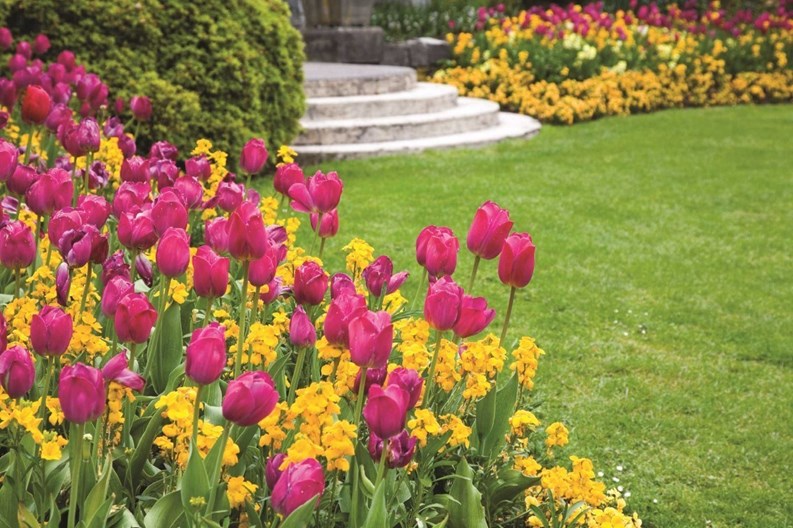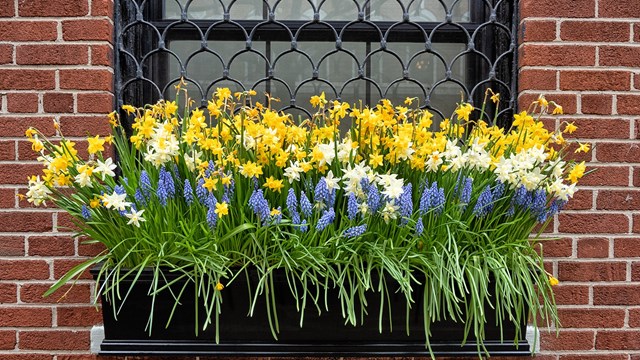The phrase, “April showers bring May flowers” is a classic—but in real-life condo communities, beautiful, abundant flowers are a bit more complicated than merely a little bit of rainfall, and don’t just spring up overnight. Colorful flowers are the first true sign that spring is officially here after a long, harsh winter. And while they are aesthetically pleasing, they can be also be a headache for condominium boards, mostly because of all the decisions involved.
From choosing between annuals and perennials to what sorts of mulch to use in what types of areas, spring landscaping is not a task to take lightly. Beyond the costs involved, these decisions also influence the way your property looks—and can affect potential buyers and the happiness of current residents.
With that in mind, when should the work start? Lynne Kelly, president of Kelly Property Management in Burlington, Massachusetts, says you can start seasonal planting as soon as the bitter frost is gone. “You’ve got to watch the weather, unfortunately. After Memorial Day is when you can tell when you can put them in, depending on how much sun the area’s getting.”
Annuals vs. Perennials
When it comes to choosing which plantings are right for your condominium community, there are two major options: Annuals and perennials. While annuals germinate, flower, and die within one year, perennials are longer lasting, returning at least three years or more. Because of this, they are often the condominium board’s go-to for easy, effective spring landscaping:
“You can use both,” said Kelly. “But it’s a matter of placement of the proper species so you’re complementing an area.”
When choosing which flower works best for various parts of your property, the landscape or garden committee will have to determine a few things. Knowing how much attention particular flowers will need as time goes on, who is going to give them that attention, and if the flower is prone to produce seeds and spread is a must.
“I try to put as many perennials in the ground as possible, because for condominiums, you put them in the ground once and they keep coming back, so that’s money saved,” said Ken Foley, president of NextGen Property Management, with offices in Merrimac and Woburn, Massachusetts.
While annuals may be more floriferous and brighten up areas, they can also be a pain, Foley warns.
“You need the labor to put [annuals] in, and the labor to pull them out, so you’re really looking at a double the effort,” said Foley. “They also mean time, money and decision-making. Anywhere there’s annuals, there’s phone calls. You know, ‘they’re not being watered enough,’ or ‘some of them are dead.’ That sort of stuff. Annuals require a lot of extra maintenance.”
The solution to all of the tough work associated with annuals? Use them sparingly and intelligently. If you are going to opt for annuals, do it in the places that really count. Some of the best locations around a property for annuals include the main entrance, common spaces like a clubhouse or pool area, and other upfront locations to attract potential residents to the property. If you want to avoid planting annuals in the ground, you can always choose hanging plants instead.
Kevin Cryan, president of Cryan Landscape in Seekonk, Massachusetts, cautions condominium boards to be cautious about what they are getting into with the type of flowers selected. Like any other plant, both annuals and perennials change and grow as time goes on after planting.
“Take the plant characteristics into consideration,” advises Cryan. “How tall will they grow? Will they box out what you want behind them or in front?”
Defining Committees
Many residents want to get involved with the aesthetics of their condo neighborhood by forming landscaping committees. These committees, which generally meet anywhere from bimonthly to biweekly, are a way for residents to get active and have a say in the look of their neighborhood. The role committees play as well as their degree of involvement differs from site to site. However, one thing remains constant: Every committee needs guidelines.
“I’m a big believer that when you have a committee you set up some rules for the committee,” Foley explains. “You say, for example, the landscaping committee is going to start on May 1 and dissolve on August 30, and here are your jobs, specified. If you get a landscaping committee that runs amuck, they have high expectations of themselves and people will tend to call them instead of the management company—so you really have to keep control of things at any given time so you know what’s going on in your community. If you don’t, they might assume responsibilities that they are executing are greater than they actually are.”
Committees can also be involved past the landscaping planning stage. It could very well be getting their hands dirty and helping with the smaller planting projects or helping the condominium board with the upkeep of an area, and as long as their actions have been approved by the condominium board, it’s a go.
“When a committee has a great success, it’s wonderful,” says Foley. “When a committee has a failure, it’s terrible.”
Mulching 101
Mulch is also a very important part of the landscaping process. Using the wrong mulch, or too much, and the money you’ve spent on putting in flowers could go to waste.
The first question: When do you mulch? The general answer: Annually. Putting down new mulch once a year freshens up the area. If a community is looking to save a few bucks, Foley suggests turning over the mulch from the year before. Often, the result will be a community with a fresh look, and money remains in the board’s budget.
The next question: How much mulch is the right amount of mulch?
“Some people think mulch, and if two inches is good then three inches or four inches should be better,” says Cryan. “That is bad. Too much mulch will do worse damage than none. It can bury the plants.”
It’s important to note is that mulch doesn’t break down quickly. When landscapers put too much mulch down, it takes even longer to do so—and if this trend continues the next season, you could be digging through six inches of mulch to get to the actual soil.
The next decision: What type of mulch is the best for your property?
“I would recommend using whatever you can get that is the closest to natural mulch and your plants will thank you,” says Cryan. “Stay away from fresh woodchips; these should not be put around plants.”
“You want to make sure that what you’re using has some nutrient value,” adds Stephen Crowe, president of Sunshine Landscaping Company in Cherry Valley, Massachusetts. Crowe generally opts for peat humus, a mixture of organic materials which have been shredded and screened to make easy, workable soil, along with composted materials and darker mulch. “Otherwise you’ll have to fertilize those annual flowers; about every two to four weeks, they will need some sort of fertilizer.”
Crowe also cautions condominium boards about the use of bark mulch. While the look of it may be visually pleasing, it can suffocate the flowers and make weeding your plantings very, very difficult.
Additionally, there are some other things to be cautious about when it comes to mulching. Beware of the ‘volcano mulching” practice, or putting your mulch into a hill formation around your ornamental trees. Just like the decision to use thicker bark mulch may look attractive but it will slowly kill the tree in the long run.
Getting Technical
So now you’ve made the decision of where to put your annuals versus your perennials and what kind of mulch you’re going to use. Next on the agenda is deciding what specific types of flowers you want to put in the ground. This decision should be based on the characteristics of an area.
“Take conditions into consideration before planting,” Cryan suggests, or your planting program may ultimately fail.
Examine what types of soil the flowers are going into, what sort of light the particular area gets, and whether it is a high traffic or low traffic locale. You also have to remember that these flowers are going to need a steady flow of water.
“You want to put flowers where the irrigation system is going to be able to water them, at least once a week or so,” advises Crowe.
For shaded areas, a suggestion would be impatiens and begonias. In the sun, it’s a different story. “Geraniums, marigolds, and New Guinea Impatiens do well in the sun,” said Crowe.
Of course, the more flowers that a community wants, the more it’s going to cost. In the current economy, some condo boards are trying to cut back on these “extras.” However, it’s important to find ways that won’t sacrifice the attractiveness of a property to potential buyers.
If a board is looking to cut back on their landscaping budget, experts suggest doing so in ways that are less noticeable. This could mean relying more on perennials for aesthetic results that will last multiple seasons, or focusing your gardening projects in the highest-viewed areas instead of along private walkways.
After a long New England winter, everyone appreciates the cheerful color that well-planned and well-kept flower gardens bring. So pull out the nursery catalogs, have a conversation with the landscaping professionals, and start that summer dreaming. Planting season is just around the corner.
Emily Abbate is a freelance writer and a frequent contributor to New England Condominium.







Leave a Comment